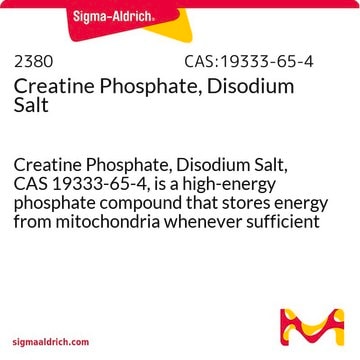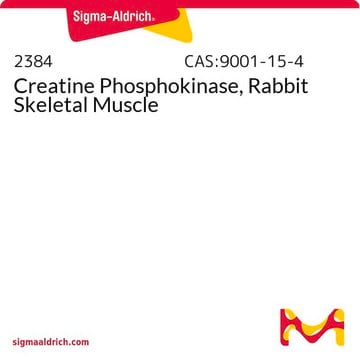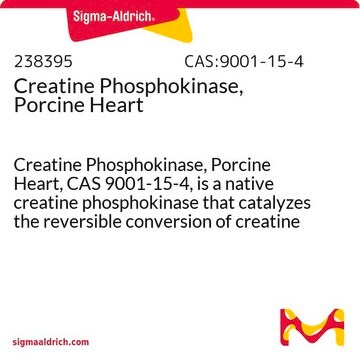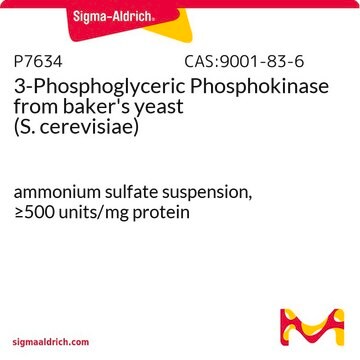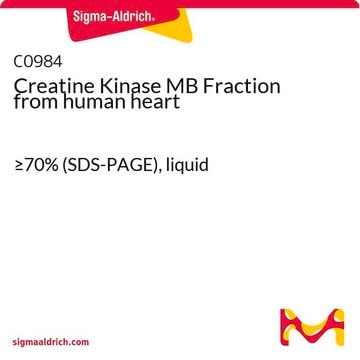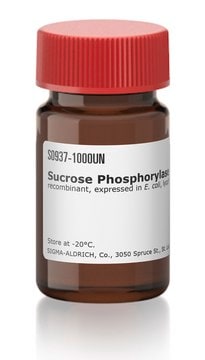The activity of this product is determined by a specific testing protocol. An assay kit is not used. The detailed protocol can be shared with customers: https://www.sigmaaldrich.com/deepweb/assets/sigmaaldrich/marketing/global/documents/354/182/creatine_phosphokinase.pdf
C3755
Creatine Phosphokinase from rabbit muscle
Type I, salt-free, lyophilized powder, ≥150 units/mg protein
Sinonimo/i:
ATP: Creatine N-Phosphotransferase, CPK, Creatine Kinase, Phosphocreatine phosphokinase
Scegli un formato
Scegli un formato
About This Item
Prodotti consigliati
Tipo
Type I
Stato
salt-free, lyophilized powder
Attività specifica
≥150 units/mg protein
PM
80-86.2 kDa
Solubilità
0.25 M glycyl-glycine, pH 7.4: soluble 5.0 mg/mL, clear, colorless to slightly yellow
Attività estranea
ATPase ≤0.01%
Lactic dehydrogenase, hexokinase, myokinase and pyruvate kinase ≤0.001%
Condizioni di spedizione
wet ice
Temperatura di conservazione
−20°C
Cerchi prodotti simili? Visita Guida al confronto tra prodotti
Applicazioni
Creatine Phosphokinase is a dimer composed predominantly of the skeletal muscle derived homodimer (MM). CK also exists as a heterodimer (MB) particularly in the myocardium. CK derived from brain tissue consists mainly of the brain source homodimer (BB). The amino acid sequences of the M chain and B chains are about 80% homologous. From the sequence, the molecular weight of the M chain is 43,112.
E1%(280)= 8.76
pH Optimum: pH 8.8-9.0 for the forward reaction and pH 6.0-7.0 for the reverse reaction.
CK is a cellular enzyme with a wide tissue distribution. Its physiological role is associated with ATP generation for contractile or transport systems. Increased levels of CK are associated with myocardial infarction, muscular dystrophy, hyperthyroidism, pulmonary infarction and cerebrovascular disease. Variations in relative isozyme distribution can provide additional information in the diagnosis of these conditions.
Substrates: Creatine, N-ethylglycocyamine and glyocyamine have been shown to act as substrates for CK. CK is very specific for ATP/ADP.
Inhibitors: ADP is a strong inhibitor of the forward reaction competing with ATP. Divalent cations such as Ca2+ (Ki=4.5 mM), Zn2+ and Cu2+ inhibit CK by competing with Mg2+. Other inhibitors include acetate, acetylsalicylic acid, adenosine, p-aminosalicylic acid, AMP, benzoic acid, bicarbonate, bromide, chloride, p-Chloromercuribenzoic acid, ethylene oxide, 2,4-fluorodinitrobenzene, iodide, malonic acid, NAD, nitrate, phosphate, pyrophosphate, salicylic acid, sulfate, sulfite, thyroxine, trichloroacetate, L-triiodothyroxine, L-triiodothyronine, and tripolyphosphate.
Avvertenza
Definizione di unità
Nota sulla preparazione
Risultati analitici
Codice della classe di stoccaggio
11 - Combustible Solids
Classe di pericolosità dell'acqua (WGK)
WGK 3
Punto d’infiammabilità (°F)
Not applicable
Punto d’infiammabilità (°C)
Not applicable
Dispositivi di protezione individuale
Eyeshields, Gloves, type N95 (US)
Scegli una delle versioni più recenti:
Certificati d'analisi (COA)
Non trovi la versione di tuo interesse?
Se hai bisogno di una versione specifica, puoi cercare il certificato tramite il numero di lotto.
Possiedi già questo prodotto?
I documenti relativi ai prodotti acquistati recentemente sono disponibili nell’Archivio dei documenti.
I clienti hanno visto anche
-
How is the activity of this product determined? Which specific assay kit is used? I would like to use it to verify the listed activity on this product's label.
1 risposta-
Utile?
-
Filtri attivi
Il team dei nostri ricercatori vanta grande esperienza in tutte le aree della ricerca quali Life Science, scienza dei materiali, sintesi chimica, cromatografia, discipline analitiche, ecc..
Contatta l'Assistenza Tecnica.


